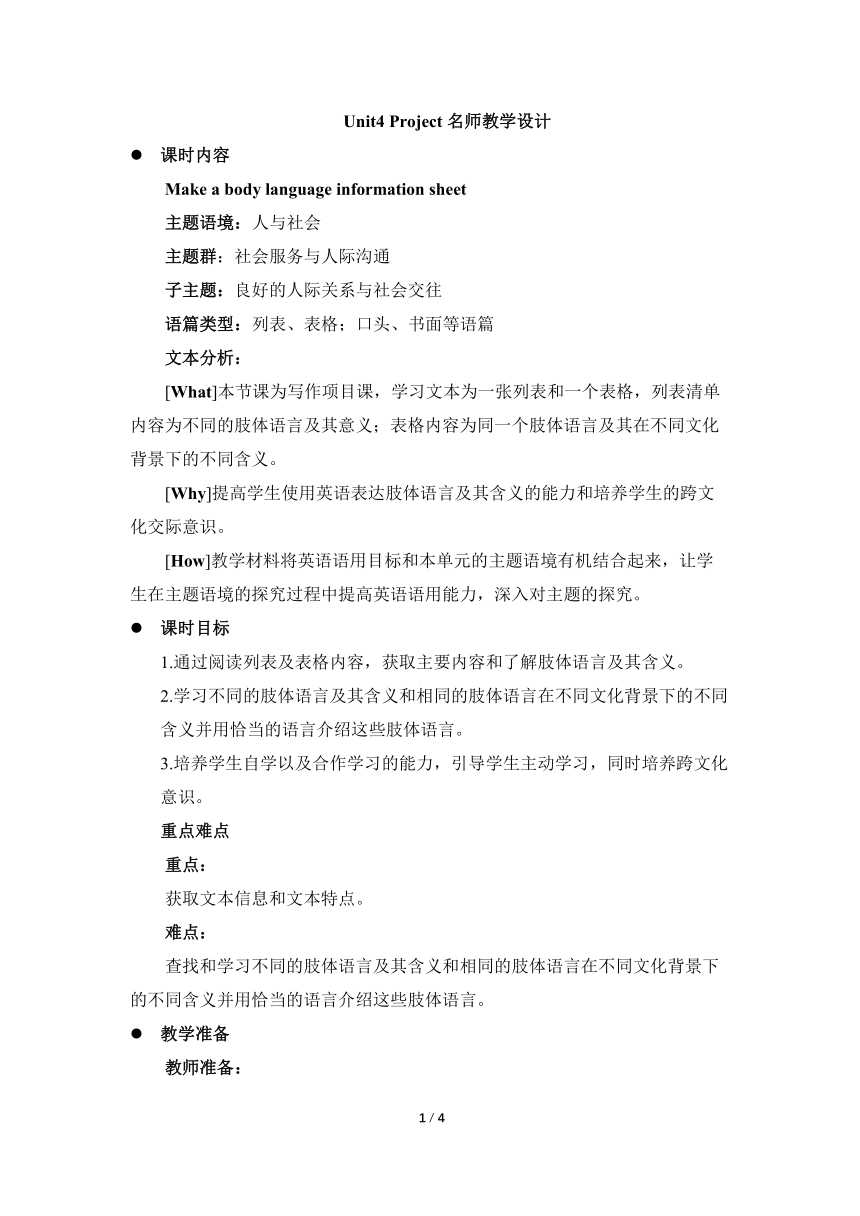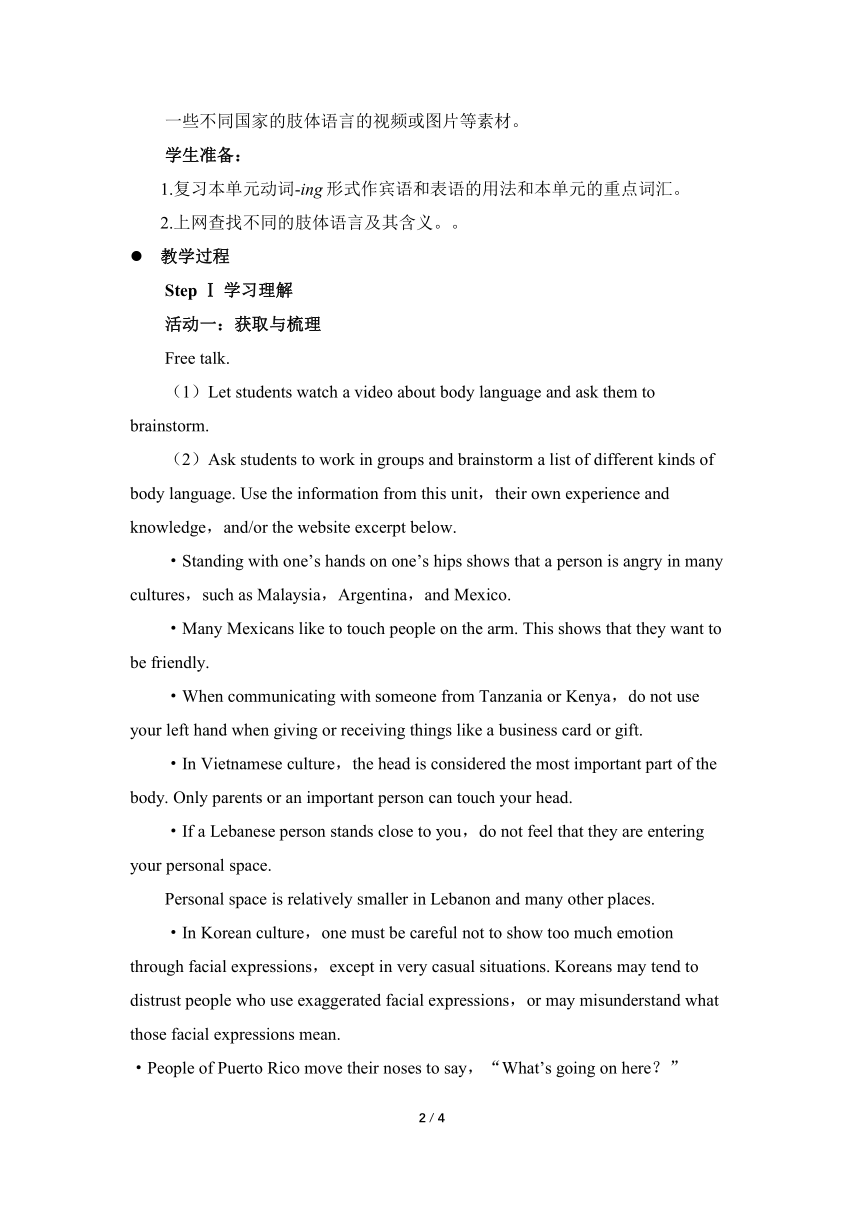人教版(2019)选择性必修 第一册Unit 4 Body Language Project名师教学设计
文档属性
| 名称 | 人教版(2019)选择性必修 第一册Unit 4 Body Language Project名师教学设计 |  | |
| 格式 | docx | ||
| 文件大小 | 19.1KB | ||
| 资源类型 | 教案 | ||
| 版本资源 | 人教版(2019) | ||
| 科目 | 英语 | ||
| 更新时间 | 2023-03-11 20:48:14 | ||
图片预览


文档简介
Unit4 Project 名师教学设计
课时内容
Make a body language information sheet
主题语境:人与社会
主题群:社会服务与人际沟通
子主题:良好的人际关系与社会交往
语篇类型:列表、表格;口头、书面等语篇
文本分析:
[What]本节课为写作项目课,学习文本为一张列表和一个表格,列表清单内容为不同的肢体语言及其意义;表格内容为同一个肢体语言及其在不同文化背景下的不同含义。
[Why]提高学生使用英语表达肢体语言及其含义的能力和培养学生的跨文化交际意识。
[How]教学材料将英语语用目标和本单元的主题语境有机结合起来,让学生在主题语境的探究过程中提高英语语用能力,深入对主题的探究。
课时目标
1.通过阅读列表及表格内容,获取主要内容和了解肢体语言及其含义。
2.学习不同的肢体语言及其含义和相同的肢体语言在不同文化背景下的不同含义并用恰当的语言介绍这些肢体语言。
3.培养学生自学以及合作学习的能力,引导学生主动学习,同时培养跨文化意识。
重点难点
重点:
获取文本信息和文本特点。
难点:
查找和学习不同的肢体语言及其含义和相同的肢体语言在不同文化背景下的不同含义并用恰当的语言介绍这些肢体语言。
教学准备
教师准备:
一些不同国家的肢体语言的视频或图片等素材。
学生准备:
1.复习本单元动词-ing形式作宾语和表语的用法和本单元的重点词汇。
2.上网查找不同的肢体语言及其含义。。
教学过程
Step Ⅰ 学习理解
活动一:获取与梳理
Free talk.
(1)Let students watch a video about body language and ask them to brainstorm.
(2)Ask students to work in groups and brainstorm a list of different kinds of body language. Use the information from this unit,their own experience and knowledge,and/or the website excerpt below.
·Standing with one’s hands on one’s hips shows that a person is angry in many cultures,such as Malaysia,Argentina,and Mexico.
·Many Mexicans like to touch people on the arm. This shows that they want to be friendly.
·When communicating with someone from Tanzania or Kenya,do not use your left hand when giving or receiving things like a business card or gift.
·In Vietnamese culture,the head is considered the most important part of the body. Only parents or an important person can touch your head.
·If a Lebanese person stands close to you,do not feel that they are entering your personal space.
Personal space is relatively smaller in Lebanon and many other places.
·In Korean culture,one must be careful not to show too much emotion through facial expressions,except in very casual situations. Koreans may tend to distrust people who use exaggerated facial expressions,or may misunderstand what those facial expressions mean.
·People of Puerto Rico move their noses to say,“What’s going on here?”
【设计意图】通过观看不同国家的肢体语言,拓宽学生知识面,并让其学习列表中所给出的不同国家的肢体语言的同时,集思广益,讨论不同的肢体语言,培养学生的文化意识,也使学生为接下来的表格填充及后续教学活动做好准备。
Step Ⅱ 应用实践
活动二:分析与判断
1.Work in groups of four. Based on your list,research online to discover what the same kinds of body language mean in different cultures.
Student A:research online to discover body language,for example,the different meanings of“OK”sign in different cultures.
Student B:research smiling used in different cultures.
Student C:research agreement and disagreement in different cultures.
Student D:research anger and happiness in different cultures.
…
2.Quickly set down the different meanings for the presentation.
3.Each group member works to finish the task efficiently.
【设计意图】本活动通过小组合作的方式让学生分工合作,利用网络查找相同的肢体语言在不同的文化中的不同含义。在深化对主题的理解的同时,培养学生的文化意识和团队合作精神,同时搜集素材为接下来的学习活动做铺垫。
活动三:内化与运用
Each group should come up with its own body language information sheet like the example below. Drawings and/or photos can be added to show what the different forms of body language look like.
(1)Assign group members to prepare the following.
□ a list of the same kinds of body language which has different meanings in different cultures
□ drawings and/or photos of the body language which they discovered online
□ a short introduction to body language
□a performance
(2)Put your introduction,drawings and/or photos together to make a sheet.
【设计意图】安排小组成员准备表格的素材,包括对肢体语言的简短介绍、形象的图片或绘画和身体力行的表演,通过小组合作,不仅节约学习活动的时间,又培养学生的小组合作能力和团队精神。
Step Ⅲ 迁移创新
活动四:批判与评价
1.Take turns presenting your sheet to the class in groups of four,and give an introduction to your body language. Then vote on the best group.
2.Review each other’s work according to the checklist:
·Is there as much body language as possible?
·Are there drawings and/or photos of body language?
·Is there a brief introduction to the body language?
·Is the performance vivid?
·What can you learn from the presentation?
【设计意图】该环节让学生以小组方式对小组的表格作品进行批判性评价,加深对主题意义的理解和对多元思维的培养,有利于实现深度学习。
板书设计
Unit 4 Body Language Period Ⅶ Project Ⅰ.学习理解 活动一:获取与梳理 Ⅱ.应用实践 活动二:分析与判断 活动三:内化与运用 Ⅲ.迁移创新 活动四:批判与评价
2 / 2
课时内容
Make a body language information sheet
主题语境:人与社会
主题群:社会服务与人际沟通
子主题:良好的人际关系与社会交往
语篇类型:列表、表格;口头、书面等语篇
文本分析:
[What]本节课为写作项目课,学习文本为一张列表和一个表格,列表清单内容为不同的肢体语言及其意义;表格内容为同一个肢体语言及其在不同文化背景下的不同含义。
[Why]提高学生使用英语表达肢体语言及其含义的能力和培养学生的跨文化交际意识。
[How]教学材料将英语语用目标和本单元的主题语境有机结合起来,让学生在主题语境的探究过程中提高英语语用能力,深入对主题的探究。
课时目标
1.通过阅读列表及表格内容,获取主要内容和了解肢体语言及其含义。
2.学习不同的肢体语言及其含义和相同的肢体语言在不同文化背景下的不同含义并用恰当的语言介绍这些肢体语言。
3.培养学生自学以及合作学习的能力,引导学生主动学习,同时培养跨文化意识。
重点难点
重点:
获取文本信息和文本特点。
难点:
查找和学习不同的肢体语言及其含义和相同的肢体语言在不同文化背景下的不同含义并用恰当的语言介绍这些肢体语言。
教学准备
教师准备:
一些不同国家的肢体语言的视频或图片等素材。
学生准备:
1.复习本单元动词-ing形式作宾语和表语的用法和本单元的重点词汇。
2.上网查找不同的肢体语言及其含义。。
教学过程
Step Ⅰ 学习理解
活动一:获取与梳理
Free talk.
(1)Let students watch a video about body language and ask them to brainstorm.
(2)Ask students to work in groups and brainstorm a list of different kinds of body language. Use the information from this unit,their own experience and knowledge,and/or the website excerpt below.
·Standing with one’s hands on one’s hips shows that a person is angry in many cultures,such as Malaysia,Argentina,and Mexico.
·Many Mexicans like to touch people on the arm. This shows that they want to be friendly.
·When communicating with someone from Tanzania or Kenya,do not use your left hand when giving or receiving things like a business card or gift.
·In Vietnamese culture,the head is considered the most important part of the body. Only parents or an important person can touch your head.
·If a Lebanese person stands close to you,do not feel that they are entering your personal space.
Personal space is relatively smaller in Lebanon and many other places.
·In Korean culture,one must be careful not to show too much emotion through facial expressions,except in very casual situations. Koreans may tend to distrust people who use exaggerated facial expressions,or may misunderstand what those facial expressions mean.
·People of Puerto Rico move their noses to say,“What’s going on here?”
【设计意图】通过观看不同国家的肢体语言,拓宽学生知识面,并让其学习列表中所给出的不同国家的肢体语言的同时,集思广益,讨论不同的肢体语言,培养学生的文化意识,也使学生为接下来的表格填充及后续教学活动做好准备。
Step Ⅱ 应用实践
活动二:分析与判断
1.Work in groups of four. Based on your list,research online to discover what the same kinds of body language mean in different cultures.
Student A:research online to discover body language,for example,the different meanings of“OK”sign in different cultures.
Student B:research smiling used in different cultures.
Student C:research agreement and disagreement in different cultures.
Student D:research anger and happiness in different cultures.
…
2.Quickly set down the different meanings for the presentation.
3.Each group member works to finish the task efficiently.
【设计意图】本活动通过小组合作的方式让学生分工合作,利用网络查找相同的肢体语言在不同的文化中的不同含义。在深化对主题的理解的同时,培养学生的文化意识和团队合作精神,同时搜集素材为接下来的学习活动做铺垫。
活动三:内化与运用
Each group should come up with its own body language information sheet like the example below. Drawings and/or photos can be added to show what the different forms of body language look like.
(1)Assign group members to prepare the following.
□ a list of the same kinds of body language which has different meanings in different cultures
□ drawings and/or photos of the body language which they discovered online
□ a short introduction to body language
□a performance
(2)Put your introduction,drawings and/or photos together to make a sheet.
【设计意图】安排小组成员准备表格的素材,包括对肢体语言的简短介绍、形象的图片或绘画和身体力行的表演,通过小组合作,不仅节约学习活动的时间,又培养学生的小组合作能力和团队精神。
Step Ⅲ 迁移创新
活动四:批判与评价
1.Take turns presenting your sheet to the class in groups of four,and give an introduction to your body language. Then vote on the best group.
2.Review each other’s work according to the checklist:
·Is there as much body language as possible?
·Are there drawings and/or photos of body language?
·Is there a brief introduction to the body language?
·Is the performance vivid?
·What can you learn from the presentation?
【设计意图】该环节让学生以小组方式对小组的表格作品进行批判性评价,加深对主题意义的理解和对多元思维的培养,有利于实现深度学习。
板书设计
Unit 4 Body Language Period Ⅶ Project Ⅰ.学习理解 活动一:获取与梳理 Ⅱ.应用实践 活动二:分析与判断 活动三:内化与运用 Ⅲ.迁移创新 活动四:批判与评价
2 / 2
